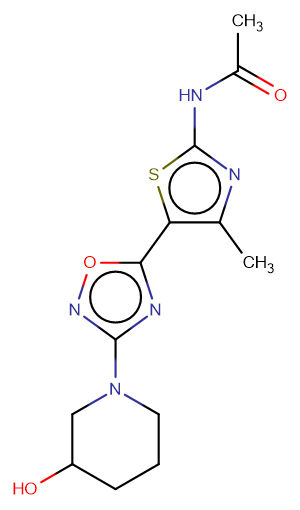
TASP0415914
CAS No. 1292300-75-4
TASP0415914 ( —— )
Catalog No. M21131 CAS No. 1292300-75-4
TASP0415914 is an orally potent inhibitor of phosphoinositide 3-kinase γ (PI3Kγ).
Purity : >98% (HPLC)
 COA
COA
 Datasheet
Datasheet
 HNMR
HNMR
 HPLC
HPLC
 MSDS
MSDS
 Handing Instructions
Handing Instructions
| Size | Price / USD | Stock | Quantity |
| 2MG | 132 | Get Quote |


|
| 5MG | 222 | Get Quote |


|
| 10MG | 357 | Get Quote |


|
| 25MG | 597 | Get Quote |


|
| 50MG | 851 | Get Quote |


|
| 100MG | 1152 | Get Quote |


|
| 200MG | Get Quote | Get Quote |


|
| 500MG | Get Quote | Get Quote |


|
| 1G | Get Quote | Get Quote |


|
Biological Information
-
Product NameTASP0415914
-
NoteResearch use only not for human use.
-
Brief DescriptionTASP0415914 is an orally potent inhibitor of phosphoinositide 3-kinase γ (PI3Kγ).
-
DescriptionTASP0415914 is an orally potent inhibitor of phosphoinositide 3-kinase γ (PI3Kγ).
-
Synonyms——
-
PathwayPI3K/Akt/mTOR signaling
-
TargetPI3K
-
RecptorPI3Kγ
-
Research Area——
-
Indication——
Chemical Information
-
CAS Number1292300-75-4
-
Formula Weight323.37
-
Molecular FormulaC13H17N5O3S
-
Purity>98% (HPLC)
-
Solubility——
-
SMILESCC(=O)Nc1nc(C)c(-c2nc(N3CCCC(O)C3)no2)s1
-
Chemical NameN-{5-[3-(3-hydroxypiperidin-1-yl)-124-oxadiazol-5-yl]-4-methyl-13-thiazol-2-yl}acetamide
Shipping & Storage Information
-
Storage(-20℃)
-
ShippingWith Ice Pack
-
Stability≥ 2 years
Reference
1.Oka Y Yabuuchi T Oi T et al. Discovery of N-{5-[3-(3-hydroxypiperidin-1-yl)-124-oxadiazol-5-yl]-4-methyl-13-thiazol-2-ylacetamide (TASP0415914) as an orally potent phosphoinositide 3-kinase γ inhibitor for the treatment of inflammatory diseases[J]. Bioorganic & Medicinal Chemistry 2013 21(24):7578-7583.
molnova catalog


related products
-
PI3K-IN-16
PI3K-IN-16 is a potent and selective, orally bioavailable PI3Kβ and PI3Kδ inhibitor.
-
Copanlisib dihydroch...
Copanlisib dihydrochloride is an ATP-competitive pan-class I PI3K inhibitor (IC50s: 0.5 nM, 0.7 nM, 3.7 nM and 6.4 nM for PI3Kα, PI3Kδ, PI3Kβ and PI3Kγ).
-
APY0201
APY0201 is a potent, highly selective, ATP-competitive PIKfyve inhibitor (IC50=5.2 nM) that interrupts the conversion of phosphatidylinositol 3-phosphate (PtdIns3P) to PtdIns(3,5)P2.



 Cart
Cart
 sales@molnova.com
sales@molnova.com


